




Professional Tips and Design Ideas for Stainless Cable Fences An attractive fence can serve as a cohesive design element in any new or existing landscape. Well planned outdoor designs will create a flow using a blend of colors and textures; no single element should stand out among the rest. The materials and colors we choose will largely determine the aesthetics and longevity of exterior cable fences. Consider the following information and construction ideas for your next fencing project: Wooden Posts and Rails– Using wood timbers for cable fences is an excellent way to create a natural look and a warmer feel than a vertical picket or rod iron fence. If durability is a concern when embedding wood posts “in ground” with concrete footings: A concrete casting tip for extending the life of wooden fence posts is to coat the bottom 12″-24″ (depending on footing depth) of the post with asphalt emulsion or asphalt fence paint prior to setting them in concrete. Using pressure treated wood timbers is another way to extend the life of any wood members making ground contact. In previous years the green color of pressure treated lumber was a turn off, but today most pressure treated utilizes a brown stain which tends to blend better with other woods/composites. Penetrating oil finishes and exterior paints also work well on wooden cable fences and provide the user with a multitude of natural and colored finish options. Steel Posts and Rails– Using steel members to construct your cable fence will typically increase the durability and minimize the visual profile of the fence frame. From a design perspective we should consider the age and style of the home as well as the existing landscape. A few tips for steel framed cable fences: Mild steel should never be considered as a material option for cable fences. The perforations will allow moisture to enter the posts and corrode them from the inside out. Galvanized and stainless steel fence posts are better options than raw steel or rod iron for exterior fences. A wooden top cap can really soften the look of any steel frame; especially outdoors. Additionally, you can avoid an industrial looking fence just by adding a simple piece of timber. Ipe’ hardwood lasts 30 to 50 years and will not jeopardize the durability of your fence. Cedar and Redwood are also popular cap choices. Choose colors that exist in place, or use bare stainless. Unless you are trying to showcase your fence, it should blend into the landscape. Grey tones and bare stainless steel with non reflective finishes are muted and work well for the most transparent fences. Are you considering a stainless steel cable fence? We offer complete fencing packages and design assistance as well as nationwide shipping. Give us a call at 844-277-7327 or visit the quote request page.
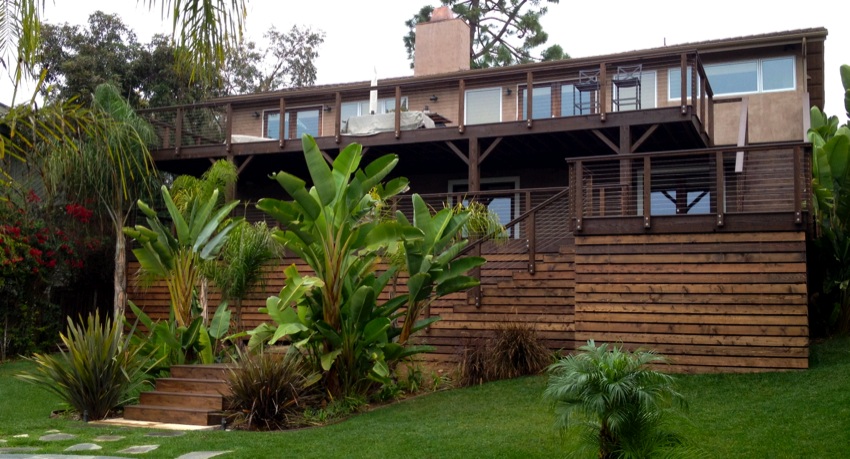
Popular Wood Types and Top Choices for Outdoor Living Spaces IPE’ – Pronounced (ee-pay) is a Brazilian hardwood species from the ironwood family. Ipe is typically sourced in South America and Central America. Timbers milled from Ipe trees are extremely dense and resistant to rot, insects and decay. Coastal decks and railings are great applications for using hardwoods like Ipe, and the planks are commonly used on docks and marinas. Due to the popularity and import cost of this material the price point is one of the highest among exterior building material types. The structural integrity and lifespan of this product make it well worth the premium for most builders. Western Red Cedar- Commonly used for posts decking and shingles, WRC is a solid choice for exterior projects. Cedar trees are most commonly found in the Pacific Northwest, and lumber is easily sourced in Washington, California, and Oregon. Cedar timbers have attractive grain patterns and colors ranging from light tan to reddish brown. Western red cedar timbers are naturally resistant to insects and decay making them popular choices for fencing, garden boxes, decks and railings. The price point for high quality cedar is much less than hardwoods and some composite products making it an attractive option. Western Red Cedar can be stained or painted quite easily. Redwood- Well known and widely used, Redwood has been one of the most popular exterior building materials for decades. The tannin acids found in redwood make it naturally resistant to insects, and the red and white marbled color make it an attractive timber. Redwood trees are commonly found in Northern California and historical old growth trees are no longer harvested by the lumber industry. Due to the farming and harvesting of younger trees, the quality of the timbers has suffered in recent years. A noticeable increase in whitewood boards is a result of harvesting these young trees . Heartwood (harder to find) is the highest quality and grade with a deep pinkish red color. Redwood is generally soft and needs to be maintained in order to preserve its longevity. Fencing decking and siding are popular exterior applications for the use of Redwood. The price point for Redwood is generally low for construction grade lumber. If you have questions about exterior wood types for a deck, railing or fencing project contact one of our sales professionals at 844-277-7327.
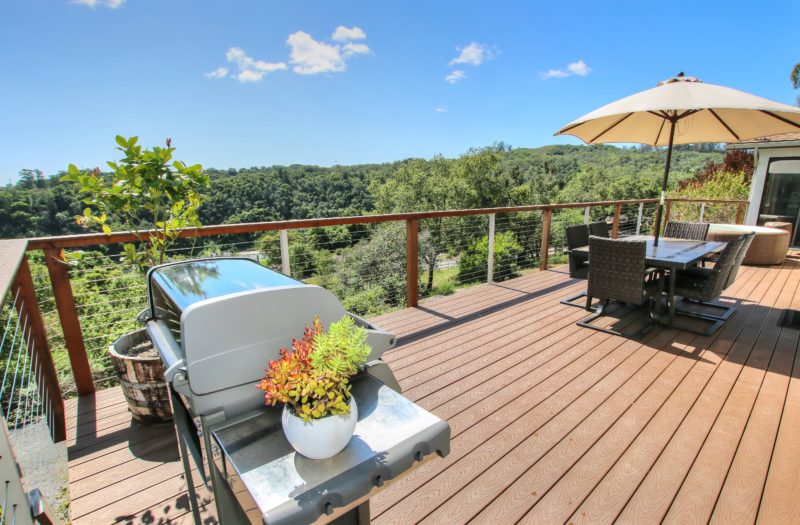
Did you know that you can build your own cable railing? We have DIY customers in all 50 states that have utilized our product line in order to assemble cable railings and fences. Our experienced staff and user friendly cable railing systems will provide everything you need to build your own cable railing. Our project photograph in this article showcases a beautiful deck railing that combines wooden posts with intermediate picket posts. Generally, wooden railings and fences are a bit easier to build for the average do it yourselfer. Picket posts are also lightweight and easy to install. By combining wooden posts with steel pickets you can expand the viewing windows from your deck. Additionally, the lineal foot cost for a hybrid (wood/steel) railing will be lower than a complete steel or stainless steel railing. The customer that provided this photo lives in a rural setting and did not want an “ultra modern” or “contemporary” look that would stand out from the surrounding landscape. Western red cedar posts were selected for a natural look and were combined with SDCR intermediate picket posts . The intermediate picket posts were powder coated a light grey to match the house. Pickets offer a lean 1″ profile to contrast with the bulkier 3.5″ wooden posts. The neutral toned railing posts and 1/8″ stainless cable used on this railing provide a transparent framework to preserve the beautiful view. Product selection and preparation are important facets of any home remodeling project. Building your own cable railing can be fun and also provide cost savings when compared to hiring a professional. It is important to do your homework and utilize online resources and building code information prior to installing any cable railings. If you have questions about our products or need assistance with a DIY cable railing project, please use our quote request page or give us a call at 844-277-7327.
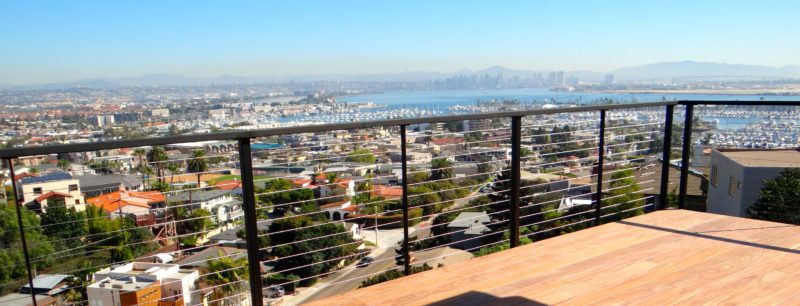
Post selection is an important part of any deck and railing design. Structural posts, intermediate pickets, and spreader posts each have unique applications. Here are some tips to help you decide which types of posts are right for your cable railing project: Structural posts are used as the support posts of any railing frame. Pertaining to cable railings, end posts and corner posts are both examples of structural railing posts. Wood, steel, stainless steel, and aluminum are common material selections for structural posts. Cable railing systems typically feature a cable count between 10 and 13 cables. When tension is applied to these cables, the majority of the tension load will be carried by the corner and end posts. For this reason, only posts that are designed to carry these type of loads should be used in these locations. Structural posts support the top railing, sustain tension, and are typically attached with bolts or concrete anchors in order to resist heavy loads. Intermediate Pickets can be utilized in order to reduce cable spread and provide a tighter post spacing with a minimized post profile. Intermediate pickets are usually made of stainless steel or aluminum tube with a 3/4″ to 1″ profile. Picket posts are placed in between structural posts with the primary purpose of reduced cable spread. Picket style posts are not usually suitable for use as support posts, however they do provide some upright support for the top railings. Intermediate pickets will allow the user to space the structural railing posts farther apart, and because of a thinner profile they should not negatively affect visibility. SDCR Intermediate Picket Posts will provide great lateral stability because of the steel construction and welded plate connections. Spreader Posts are another example of an intermediate post option that will reduce cable spread and allow for larger distances in between structural posts. SDCR “ultra slim” spreader posts are custom made flat bar posts that feature the most minimal profile available. Spreader posts are almost always made from steel or stainless steel flat bar, although we have on occasion made them from hardwood/s. Flat bar provides a very sleek look and maximum visibility. Due to the custom nature of our spreader posts, the price point for these posts is higher than a picket style post. Spreader posts are a great option for coastal applications and ocean view railings. For more information on our line up of railing posts give us a call at 844-277-7327 or click on the product links below: [ec_store groupid=”7″]
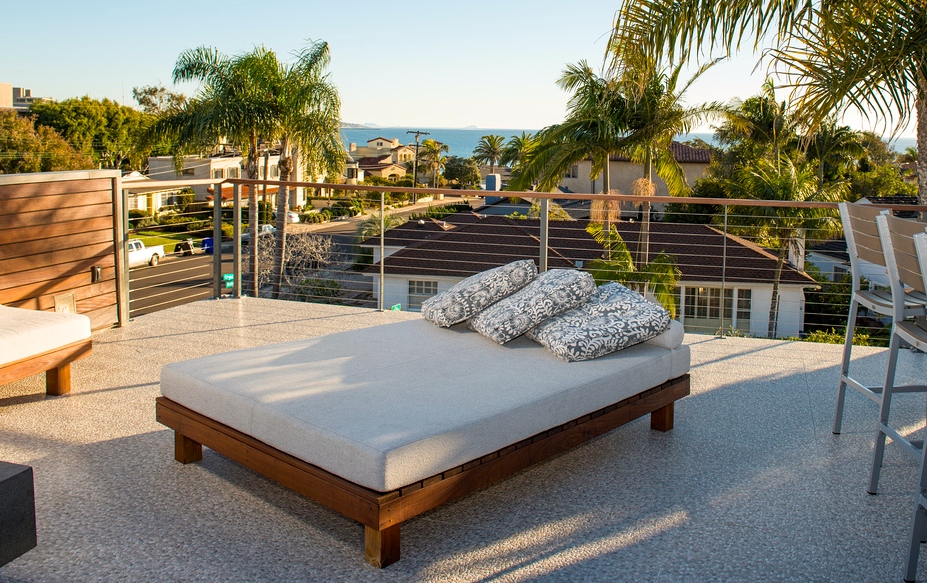
Many of our sales calls come from customers who are doing replacement or retrofit work. If you are fortunate enough to live on the California coastline; you have possibly replaced a deck or some damaged fencing. The ocean breezes we enjoy so much can take a toll on our structures and finishes. Material selection is key, and maintenance also plays a huge role in the longevity of our coastal railings and fencing systems. What is it about the ocean air that is so harsh on our exterior structures? What can we do about it? We traded notes with some of our local contractors to bring you a list of causes and remedies for coastal exposure: UV (ultra violet) Rays– Can cause cracking, fading and reduce the lifespan of building materials. Using high quality products and coatings designed to minimize the effects of UV exposure will prolong the life of decks and fences. Regular maintenance (cleaning, painting, staining) is imperative ; especially for wooden structures. Moisture– Coastal railing systems are often wet on a daily basis. Using composite products, high quality stainless steel (type 316), Ipe hardwood, and copper or stainless flashings will combat the wet conditions. Periodic cleanings and maintenance ( keeping wood painted) is an excellent way to protect your improvements. Salt– A build up of salt crystals will deteriorate just about any type of material. We are often amazed at the difference that regular maintenance (cleaning, coating) will make. A regular maintenance schedule is as simple as wiping down your railings a couple of times a year. It prevents the salt from building up on railing materials, and a good cleaner will also provide protection against the elements. Even high quality materials like stainless steel and copper will benefit from regular cleaning. For questions about coastal railings and fencing projects contact one of our cable railing pros or give us a call at 844-277-7327. We offer a variety of high quality options for coastal deck and fencing projects.
San Diego Cable Railings and Outlier Enterprises have teamed up to offer CAD (computer aided design) packages and cable railing calculations for wooden and steel framed cable railing systems. CAD software is used by architects, engineers, drafters, artists, and others to create precision drawings or technical illustrations. Comprehensive design details can be generated for your project in as little as 1-2 weeks! A typical design package will contain project specific information, connection details, and accompanying calculations for certain load requirements commonly requested for permitted deck and railing jobs. If you have a new construction project or permitted remodel, your local building department may request certain call outs or calculations to be submitted with building blueprints. They may also want a recognized railing system, or supporting documentation that proves the intended railings will withstand the loading requirements that keep people and pets safe on raised structures. If you are a designer or contractor, using an engineered cable railing system can be a fast and easy way to secure a building permit and expedite project deadlines for your customers. Our pricing and lead times for design packages and calculations will meet or beat industry standards. For turnkey project requests we can design, manufacture and recommend one of our preferred cable railing installers. Our ultimate goal is to provide our customers with the highest level of service and high quality products at a competitive price point. If you have questions about CAD design or cable railing calculations, contact us at 844-277-7327, or visit the quote request page.
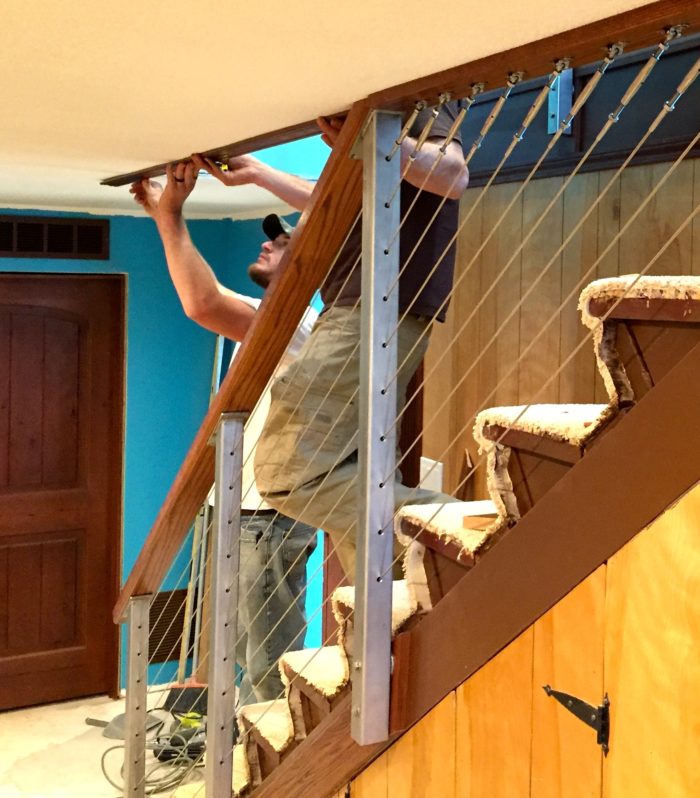
Hiring Cable Railing Contractors- Finding the right contractor for a home remodeling project can be challenging, however it is a very important step to starting a renovation. The right trade specialist can make a huge impact when it comes the the end results of any installation. In this weeks blog we will provide some tips about hiring a contractor, and share some of our own experience from working with hundreds of contractors across the country. -Hire A Specialist Hiring a specialty contractor means they should be expert level providers of the products and services that are being offered. Some good examples of specialty contractors are window installers, deck builders, and roofers. These trades typically stick to the specialized type of work they perform. For example: the window installer is not likely a good candidate for your paid cable railing installation; even if they did a great job on your windows. A deck builder or carpenter who has performed several cable railing installations on previous jobs could be a great find. Don’t hesitate to ask contractors for photos of previous projects, web addresses or even reviews from previous customers. Choosing a contractor over a DIY application should mean hiring a true PRO. -Product Knowledge Cable railing contractors should have knowledge about the products they are installing. Nobody desires to pay a premium for a contractor to learn on the job. Your contractor should be able to educate you about the products and installation that is being performed. A good contractor will make you feel comfortable providing information about the questions you may have. It’s OK to ask questions and its always better to ask them before the project starts. -Payment Licensed contractors should not ask for much money up front. In California a 10% deposit is the maximum amount allowed prior to performance of any work. A request for a 50% down payment is illegal and likely a huge red flag. Good contractors manage jobs and finance their own projects. Larger jobs may require progress payments but you should never pay a large amount of money before the work is performed. -Get a Referral Referral based business is still one of the best ways to find good contractors. At San Diego Cable Railings we have preferred contractors in San Diego, Los Angeles and the San Francisco Bay area. If you are interested in a contractor referral please give us a call or submit a quote request today. 1-844-277-7327 –

The Houzz community has awarded San Diego Cable Railings the “Best Of Houzz” customer service award for the fifth consecutive year! We would like to extend our thanks to the staff at Houzz and all of our amazing customers who submit reviews about our products and services. We appreciate the time and consideration it takes to submit these reviews as well as the valuable resource provided for the entire remodeling community. Candid reviews and online platforms have changed the way we are able to view businesses and service people. Houzz.com is a community dedicated to remodeling photos, products and professionals. Reviews from clients give potential new customers valuable information, photos and ideas for upcoming projects. Confidence is key when selecting products and services; especially for something as important as a home remodeling project. When it comes to DIY projects; previous client feedback can be a great way to research other DIY experiences and really weigh the options between hiring a pro or doing it yourself. Our cable railing service awards from Houzz cover a 5 year service period and contain a wide variety of project types and customers. Many of our reviews come from homeowners performing their first cable railing installation. If you have questions about our cable railing service awards and Houzz profile or would like to see reviews of our products and services on Houzz please click here. Our San Diego Cable Railings pro page contains project photos and descriptions as well as company information that can be a great resource when selecting a cable railing system.
Outdoor living projects can provide us with the style and extra space to relax and entertain friends. Outdoor kitchens and bbq’s as well as decks and patio structures have become more of a necessity than in previous years. Outdoor living lets us enjoy recreation without leaving the comfort of home. In general, home and lot sizes are getting smaller, so expanding our outdoor living gives us more useable space and valuable square footage. Investing in outdoor living projects can sometimes carry a substantial price tag, however the return on investment numbers may surprise you. The charted statistics from 2016 display National and West Coast (Pacific) regional remodeling averages for 2016. The chart averages show us that adding a deck actually provides a better return value than a bathroom addition or remodel. We can see from the chart data that in both National and Pacific locations, the addition of a deck provides a better value than a bathroom addition. On the west coast, the return is a staggering 88.9% return for a wood deck and 76.9% for composite decks. Question: “Why does the wood deck provide a better return than the composite product?” Answer: -The wooden deck costs less so the dollar for dollar return generates a higher percentage however based on lifespan these numbers could change. The typical lifespan of a wooden deck is 10-15 years and the lifespan of a composite deck is 20-30 years. People tend to gravitate towards decks and actually prefer the warm feel of wood and faux wood in comparison to concrete or other masonry surfaces. Projections for remodelers and contractors : Outdoor living projects rank in the top 5 new revenue sources for remodelers based on a survey by the Farnsworth Group (oct 16′). It looks to be a busy year for residential remodeling and outdoor living projects, with deck construction ranking among the most desirable additions to a residential home.
San Diego Cable Railings would like to extend many thanks and best holiday wishes to all of our customers, followers and staff. We wish everyone a safe and happy holiday season and we are looking forward to 2017! Our offices will be closed for the holiday break from 12/19/16- 1/2/17. Please feel free to submit quote requests during this timeframe, or leave us a message at 844-277-7327. 2016 has been an excellent year for home improvement projects and remodeling. As a company we are so grateful to be doing what we love for our customers across the country! We are looking forward to another great year and will see you all in 2017!!